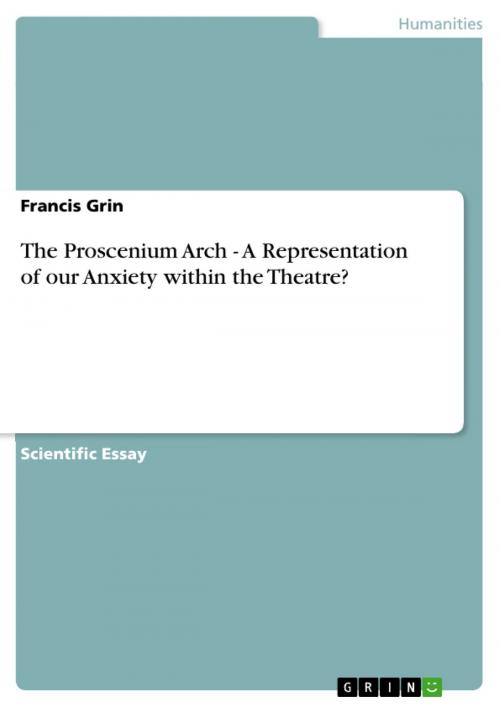The Proscenium Arch - A Representation of our Anxiety within the Theatre?
Nonfiction, Entertainment, Theatre, Performing Arts| Author: | Francis Grin | ISBN: | 9783640234271 |
| Publisher: | GRIN Verlag | Publication: | December 17, 2008 |
| Imprint: | GRIN Verlag | Language: | English |
| Author: | Francis Grin |
| ISBN: | 9783640234271 |
| Publisher: | GRIN Verlag |
| Publication: | December 17, 2008 |
| Imprint: | GRIN Verlag |
| Language: | English |
Scientific Essay from the year 2008 in the subject Theater Studies, Dance, grade: H1, University of Melbourne, course: Architecture, Space, and Theatre, 10 entries in the bibliography, language: English, abstract: The frontal set-up of the proscenium arch now marks a central point of debate regarding the nature of representation within the theatre. The proscenium's frontal architectural form seems to l ave little room for discussion as it detaches the spectator from the performance through the employment of the fourth wall. This lack of discussion has repeatedly been blamed for the reestablishment of traditional bourgeois values and hegemonic sign-systems within the theatre. (Heuvel 1992) Hence, the 20th century was more than happy to embrace the multitude of theatrical innovations as new staging concepts stirred away from the 'antiquity' of the proscenium arch, moving into a new and exciting artistic terrain that involved theatre in the round, environmental theatre, etc. (Heuvel 1992) These innovations celebrated the theatre as an interactive experience between the actors and the audience, liberating the stage from the 'dull' frontal viewing that the proscenium arch had seemed to chain itself to. Representation within these emerging theatre styles evolved into a state of 'experiencing the image' rather than merely 'viewing it' and the audience was now able to play an active role, allowing them to interact/question the sign systems on stage. Oddly enough, the proscenium still seems to be the most ommon form of staging within our Western theatre culture. Realistic, Epic, and the Post-modern Theatre of Images mark three of the most historically significant genre's within the theatrical movement, yet, these three styles predominantly employ the proscenium arch as a theatre space. Their regressive use of this staging has at times been considered reactionary, leading to anxieties about a backlash within the theatrical movement. While for some, the use of the proscenium may signify an artistic backlash, I would argue that the proscenium has undergone a crucial range of adaptations; signifying the constant evolution of representation within the theatre. Through a discussion regarding the development of the proscenium arch within the genre's of Realistic, Epic, and post-modern theatre, we can see how this staging has been able to manipulate its frontal frame as it, often successfully, responds to our constantly changing environment.
Scientific Essay from the year 2008 in the subject Theater Studies, Dance, grade: H1, University of Melbourne, course: Architecture, Space, and Theatre, 10 entries in the bibliography, language: English, abstract: The frontal set-up of the proscenium arch now marks a central point of debate regarding the nature of representation within the theatre. The proscenium's frontal architectural form seems to l ave little room for discussion as it detaches the spectator from the performance through the employment of the fourth wall. This lack of discussion has repeatedly been blamed for the reestablishment of traditional bourgeois values and hegemonic sign-systems within the theatre. (Heuvel 1992) Hence, the 20th century was more than happy to embrace the multitude of theatrical innovations as new staging concepts stirred away from the 'antiquity' of the proscenium arch, moving into a new and exciting artistic terrain that involved theatre in the round, environmental theatre, etc. (Heuvel 1992) These innovations celebrated the theatre as an interactive experience between the actors and the audience, liberating the stage from the 'dull' frontal viewing that the proscenium arch had seemed to chain itself to. Representation within these emerging theatre styles evolved into a state of 'experiencing the image' rather than merely 'viewing it' and the audience was now able to play an active role, allowing them to interact/question the sign systems on stage. Oddly enough, the proscenium still seems to be the most ommon form of staging within our Western theatre culture. Realistic, Epic, and the Post-modern Theatre of Images mark three of the most historically significant genre's within the theatrical movement, yet, these three styles predominantly employ the proscenium arch as a theatre space. Their regressive use of this staging has at times been considered reactionary, leading to anxieties about a backlash within the theatrical movement. While for some, the use of the proscenium may signify an artistic backlash, I would argue that the proscenium has undergone a crucial range of adaptations; signifying the constant evolution of representation within the theatre. Through a discussion regarding the development of the proscenium arch within the genre's of Realistic, Epic, and post-modern theatre, we can see how this staging has been able to manipulate its frontal frame as it, often successfully, responds to our constantly changing environment.















